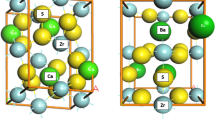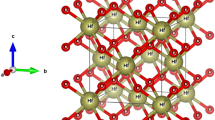Abstract
Electron-phonon coupling (EPC) in bulk materials is an important effect in multifarious physical and chemical phenomena. It is the key to explaining the mechanisms for superconductivity, electronic transport, etc. The EPC matrix describes the coupling of the electronic eigenstates of the studied system under the perturbation of phonons. Although the EPC matrix is closely relevant to many fundamental physicochemical properties, it remains a challenge to calculate the EPC matrix precisely due to the high computational cost. In recent years, Giustino et al. developed the EPW method on open-source ab-initio software Quantum Espresso, which uses Wannier functions (WFs) to calculate EPC matrix. However, due to the limitation of their implementation, it is not possible yet to calculate the EPC matrix under some important computational conditions, e.g., for DFT+U and HSE calculation. Given the importance of these computational conditions (e.g., for transition metal oxides), we have developed our own implementation of EPC matrix calculation based on the domestic ab-initio software PWmat. Our code allows the DFT+U and HSE correction, so we can get a more accurate EPC matrix in the related problems. In this article, we will first review the formulae and elucidate how to calculate the EPC matrix by constructing WFs. Then we will introduce our code along with its workflow on PWmat and present our test results of two classical semiconductor systems AlAs and Si, showing consistency with EPW. Next, the EPC matrix of LiCoO2, a classical cathode material for lithium-ion batteries, is calculated using different exchange correlation (XC) functionals including LDA, PBE, DFT+U and HSE. A comparison is provided for the related EPC matrix. It shows there could be a significant difference for the EPC matrix elements due to the use of different XC functionals. Our implementation thus opens the way for fast calculation of EPC for the important class of materials, like the transition metal oxides.
Similar content being viewed by others
References
Baroni S, de Gironcoli S, dal Corso A, et al. Phonons and related crystal properties from density-functional perturbation theory. Rev Mod Phys, 2001, 73: 515–562
Li J F, Pan Y, Wu C F, et al. Processing of advanced thermoelectric materials. Sci China Tech Sci, 2017, 60: 1347–1364
Zhang X, Qiao X F, Shi W, et al. Phonon and Raman scattering of two-dimensional transition metal dichalcogenides from monolayer, multilayer to bulk material. Chem Soc Rev, 2015, 44: 2757–2785
Giustino F. Electron-phonon interactions from first principles. Rev Mod Phys, 2017, 89: 015003
Xi J, Nakamura Y, Zhao T, et al. Theoretical studies on the deformation potential, electron-phonon coupling, and carrier transports of layered systems. Acta Physico-Chim Sin, 2018, 34: 961–976
Lazzeri M, Piscanec S, Mauri F, et al. Electron transport and hot phonons in carbon nanotubes. Phys Rev Lett, 2005, 95: 236802
Bloch F. Über die Quantenmechanik der Elektronen in Kristallgittern. Z Physik, 1929, 52: 555–600
Bardeen J, Shockley W. Deformation potentials and mobilities in nonpolar crystals. Phys Rev, 1950, 80: 72–80
Giustino F, Cohen M L, Louie S G. Electron-phonon interaction using Wannier functions. Phys Rev B, 2007, 76: 165108
Poncé S, Margine E R, Verdi C, et al. EPW: Electron-phonon coupling, transport and superconducting properties using maximally localized Wannier functions. Comput Phys Commun, 2016, 209: 116–133
Giannozzi P, Baroni S, Bonini N, et al. Quantum Espresso: A modular and open-source software project for quantum simulations of materials. J Phys-Condens Matter, 2009, 21: 395502
Zhou J J, Park J, Lu I T, et al. Perturbo: A software package for ab initio electron-phonon interactions, charge transport and ultrafast dynamics. Comput Phys Commun, 2021, 264: 107970
Zhou J J, Park J, Timrov I, et al. Ab initio electron-phonon interactions in correlated electron systems. Phys Rev Lett, 2021, 127: 126404
Zhou J J, Hellman O, Bernardi M. Electron-phonon scattering in the presence of soft modes and electron mobility in SrTiO3 perovskite from first principles. Phys Rev Lett, 2018, 121: 226603
Miglio A, Brousseau-Couture V, Godbout E, et al. Predominance of non-adiabatic effects in zero-point renormalization of the electronic band gap. npj Comput Mater, 2020, 6: 167
Brunin G, Miranda H P C, Giantomassi M, et al. Electron-phonon beyond fröhlich: Dynamical quadrupoles in polar and covalent solids. Phys Rev Lett, 2020, 125: 136601
Jia W, Cao Z, Wang L, et al. The analysis of a plane wave pseudopotential density functional theory code on a GPU machine. Comput Phys Commun, 2013, 184: 9–18
Jia W, Fu J, Cao Z, et al. Fast plane wave density functional theory molecular dynamics calculations on multi-GPU machines. J Comput Phys, 2013, 251: 102–115
Li Z. Solid Theory (in Chinese). 2nd ed. Beijing: Higher Education Press, 2017. 18–60
Togo A, Tanaka I. First principles phonon calculations in materials science. Scripta Mater, 2015, 108: 1–5
Wannier G H. The structure of electronic excitation levels in insulating crystals. Phys Rev, 1937, 52: 191–197
Marzari N, Mostofi A A, Yates J R, et al. Maximally localized Wannier functions: theory and applications. Rev Mod Phys, 2012, 84: 1419–1475
Marzari N, Vanderbilt D. Maximally localized generalized Wannier functions for composite energy bands. Phys Rev B, 1997, 56: 12847–12865
Souza I, Marzari N, Vanderbilt D. Maximally localized Wannier functions for entangled energy bands. Phys Rev B, 2001, 65: 035109
Jain A, Hautier G, Ong S P, et al. Formation enthalpies by mixing GGA and GGA+U calculations. Phys Rev B, 2011, 84: 045115
Heyd J, Scuseria G E, Ernzerhof M. Hybrid functionals based on a screened coulomb potential. J Chem Phys, 2003, 118: 8207–8215
Mostofi A A, Yates J R, Pizzi G, et al. An updated version of Wannier90: A tool for obtaining maximally-localised Wannier functions. Comput Phys Commun, 2014, 185: 2309–2310
Jie J S, Weng M Y, Li S N, et al. A new MaterialGo database and its comparison with other high-throughput electronic structure databases for their predicted energy band gaps. Sci China Tech Sci, 2019, 62: 1423–1430
Vurgaftman I, Meyer J R, Ram-Mohan L R. Band parameters for III–V compound semiconductors and their alloys. J Appl Phys, 2001, 89: 5815–5875
Huang Z, Geyer N, Werner P, et al. Metal-assisted chemical etching of silicon: A review. Adv Mater, 2011, 23: 285–308
Yang Y, Yang J L, Pan F, et al. From intercalation to alloying chemistry: Structural design of silicon anodes for the next generation of lithium-ion batteries (in Chinese). Chin J Struct Chem, 2020, 39: 16–19
Poncé S, Antonius G, Boulanger P, et al. Verification of first-principles codes: Comparison of total energies, phonon frequencies, electron-phonon coupling and zero-point motion correction to the gap between ABINIT and QE/YAMBO. Comput Mater Sci, 2014, 83: 341–348
Goodenough J B, Kim Y. Challenges for rechargeable Li batteries. Chem Mater, 2009, 22: 587–603
Ye Y, Hu Z, Liu J, et al. Research progress of theoretical studies on polarons in cathode materials of lithium-ion batteries. Acta Phys Chim Sin, 2021, 37: 2011003
Liu T C, Pan F, Amine K. Prospect and reality of concentration gradient cathode of lithium-ion batteries (in Chinese). Chin J Struct Chem, 2020, 39: 11–15
Zhang M J, Chen Y S, Pan F, et al. Understanding structural evolution in the synthesis of advanced energy materials (in Chinese). Chin J Struct Chem, 2020, 39: 26–30
van Elp J, Wieland J L, Eskes H, et al. Electronic structure of CoO, Lidoped CoO, and LiCoO2. Phys Rev B, 1991, 44: 6090–6103
Inaba M, Iriyama Y, Ogumi Z, et al. Raman study of layered rock-salt LiCoO2 and its electrochemical lithium deintercalation. J Raman Spectrosc, 1997, 28: 613–617
Chakraborty A, Dixit M, Aurbach D, et al. Predicting accurate cathode properties of layered oxide materials using the SCAN meta-GGA density functional. npj Comput Mater, 2018, 4: 60
Du T, Xu B, Wu M, et al. Insight into the vibrational and thermodynamic properties of layered lithium transition-metal oxides LiMO2 (M = Co, Ni, Mn): A first-principles study. J Phys Chem C, 2016, 120: 5876–5882
Author information
Authors and Affiliations
Corresponding authors
Additional information
This work was supported by the starting fund of Peking University Shenzhen Graduate School, Fujian Science & Technology Innovation Laboratory for Energy Devices of China (Grant No. 1C-LAB), the Chemistry and Chemical Engineering Guangdong Laboratory (Grant No. 1922018), the Soft Science Research Project of Guangdong Province (Grant No. 2017B030301013), and the Major Science and Technology Infrastructure Project of Material Genome Big-Science Facilities Platform supported by Municipal Development and Reform Commission of Shenzhen. The authors would like to thank Dr. Samuel Poncé from École Polytechnique Fédérale de Lausanne (EPFL) and Dr. Hyungjun Lee from University of Texas at Austin for their kindly help with some details about understanding EPW code.
Supporting Information
The supporting information is available online at https://tech.scichina.com and https://link.springer.com. The supporting materials are published as submitted, without typesetting or editing. The responsibility for scientific accuracy and content remains entirely with the authors.
Electronic supplementary material
Rights and permissions
About this article
Cite this article
Ye, Y., Weng, M., Zhang, W. et al. Calculating electron-phonon coupling matrix: Theory introduction, code development and preliminary application. Sci. China Technol. Sci. 66, 204–214 (2023). https://doi.org/10.1007/s11431-022-2113-y
Received:
Accepted:
Published:
Issue Date:
DOI: https://doi.org/10.1007/s11431-022-2113-y




